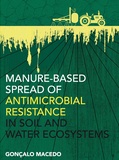Manure-based Spread of Antimicrobial Resistance in Soil and Water Ecosystems

Barroca de Macedo, Gonçalo
- Promoter:
- prof.dr ir. D.J.J. (Dick) Heederik & prof.dr D.J. (Dik) Mevius
- Co-promoter:
- Dr. H. (Heike) Schmitt & dr ir. P. (Peter) van der Maas
- Date:
- November 9, 2021
- Time:
- 14:15 h
Summary
Antimicrobial resistance (AMR) has been considered one of the major challenges to global public health, and it is now seen as a One Health concept, under which people’s health is connected to the health of animals and their shared environment. Agriculture contributes to the emergence and spread of antibiotic resistance genes (ARGs) and antibiotic residues in the environment as manure from (intensive) livestock production is widely used as fertilizer. Despite being a nutrient-rich and stable organic carbon source, the application of animal manure also results in the introduction of manure-derived bacteria and their ARGs into the soil, enriching the already occurring set of ARGs. The fate of ARGs in the environment, particularly in farmlands, is not yet clear, and this thesis set out to investigate ARG proliferation in microbial communities in the agricultural chain, from the animal gut to water (manure, soil, and water), and the extent of ARG transfer potential. Understanding the main factors driving ARG dissemination in farmlands will help define concrete points of action that aim to mitigate the spread of AMR at the farm level. Chapter 2 evaluated the soil texture’s role on ARG dynamics in manured soils and surrounding surface waters. It was demonstrated that rather than showing similar decay dynamics, factors such as the type of ARG and soil texture drive the ARG persistence in the environment. Chapter 3 explored the dynamics of bacteria and ARGs introduced by manuring to soils and adjacent water ditches, both at the community and individual scale, over three weeks. It showed that the bacteriome and resistome structures are shaped by different factors, where the bacterial community composition could not explain the changes in ARG diversity or abundances. Additionally, it also highlighted the potential of applying targeted metagenomic techniques, such as ResCap, to study the fate of AMR in the environment. Chapter 4 examined the ARG removal potential of a manure treatment process using a newly designed up-flow anaerobic sludge bed reactor operating at thermophilic conditions. It indicated that this treatment successfully removes some, but not all, bacterial groups. It also showed that the abundance of the selected ARGs was not reduced. Chapter 5 assessed how conjugation frequencies between E. coli strains in filter matings differ based on the temperature and nutrient availability. It showed that, despite less favorable conditions, plasmid transfer can occur in the environment. Therefore, fecal microorganisms in manure can be a source of AMR transmission. Chapter 6 investigated the fate of plasmids in manured soil microcosms introduced by fecal microorganisms over time. While being a laboratory simulation, it provided realistic quantifications of conjugation frequencies, and it identified the new hosts of the transferred plasmids. In the end, the findings reported throughout the thesis were discussed and the implications of research outcomes were contextualized. Action points to reduce the farm burden in environmental AMR spread were suggested.